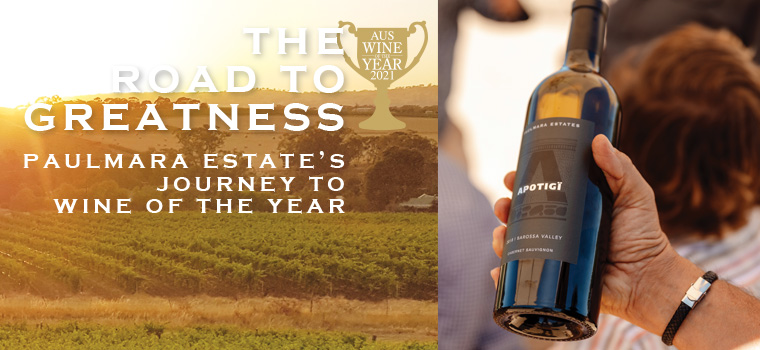Paulmara Estate’s Journey to Wine of the Year
"When I was managing the Barossa growers (for Penfolds) the pinnacle a grower could reach was Grange. I wanted to see how long it would take to plant a vine and get it to Grange."
NIGEL HOPKINS
WHEN you’ve had 18 years exploring the finest vineyards of South Australia, seeking the very best grapes to go into some of Australia’s finest wines, it should come as no surprise that when the time came to buy your own vineyard only the best would do.
That was the inside running that gave Paul Georgiadis a very significant head start when, as grower relations manager for Penfolds premium regions until 2009, with his wife Mara he bought land at Marananga in the heart of the Barossa Valley and planted their first vines in 1995.
By then Paul had a deep, intimate knowledge of the extraordinary characters of Coonawarra, McLaren Vale and other South Australian premium regions, but it was “the rolling hills of Seppeltsfield Road” that attracted him the most. He and Mara bought just under 17ha of prime vineyard land, which they called the Home Block, and planted 14ha of it mostly with shiraz, some cabernet sauvignon, about 2ha of sangiovese, some nero d’avola and mataro.
“The whole reason we planted the vineyard was to apply all the knowledge I’d gained through teaching our 600 growers and working with Patrick Iland as part of Penfold’s Wine Web Project, where we looked at all the elements that created quality in wine. Part of that was looking at what we needed to do in a vineyard to achieve that.”
At this point Paul launches into a mass of intricate detail such as leaf layer number, internode spacing and light inception, and his work in the development of Penfold’s Yattarna, RWT and other iconic wines. Little wonder that he’s sometimes referred to as a “grape whisperer”.
“It came to a point where we said why not do this for ourselves?” Paul says. “I wanted to apply everything I’d learnt to see what sort of results I could get.
“When I was managing the Barossa growers (for Penfolds) the pinnacle a grower could reach was Grange. I wanted to see how long it would take to plant a vine and get it to Grange. That was the whole ultimate goal – and to get my father out of the Riverland, where I’d grown up in Barmera, and for him to manage the vines while I was still in the corporate world.”
Not surprisingly, all of the fruit from that initial Home Block went to Penfolds until, in 1999, Paul and Mara launched their own Paulmara brand, with their first wine Syna shiraz – Greek for together – inspired by Paul’s Greek roots and Mara’s Californian heritage, where she had trained in agribusiness, worked for wineries in Sonoma County and met Paul whilst both were working at Penfolds.
The next big move came in 2011 when they bought the rundown Paradigm vineyard, 4km up the road near Marananga’s Gnadenfrei church, in partnership with four friends including Penfold’s chief winemaker Peter Gago.
Once owned by the Seppelt family, just over a third of the 25ha site had been planted with shiraz and cabernet sauvignon. Paul recalls that he bought grapes from that vineyard for Grange in 1992 and knew there was something special about its soils, but by 2011 he says, “it was all over the place, posts broken, vines on the ground, it required a total rebuild.”
This took great care. The oldest shiraz vines were thought to be more than 100 years old, the cabernet 50-60 years old, but by 2018 Paul thought the vineyard, where he’d retained its original contoured structure, was back to the standard he wanted. Until then its fruit had been sold to another winemaker, but after a disagreement over picking dates Paul decided to offer both the shiraz and cabernet to the man who’d already been making Paulmara wines, his old friend from Penfold days Jason Barrette.
Enormously experienced, Jason has more than 30 vintages behind him in France, the US, Portugal and Canada – and had 11 years with Penfolds, where he and Paul met at Magill Estate. Now working as a global winemaking consultant, Jason Barrette is general manager and chief winemaker at the Lyndoch winery Hemera Estate, where Paulmara have three of their own five-tonne fermenters.
That was when they realised just how good the 2018 Paradigm vineyard cabernet was: “As soon as it hit the tank we knew,” Paul says. What followed was a longer ferment than usual, 13 days on skins, then into new French oak, with just 100 dozen bottles produced.
Grown in tight red clays over shattered ironstone and quartz, mostly unirrigated, with yields no more than 2 tonnes/ha, the vines have to work hard to extract moisture from the soil.
“That’s one block where I don’t let anyone else touch and prune,” Paul says. “I’ll do it all myself because you have to prune it to balance, to the vine’s capacity. And in 2018 I thought we had too many bunches, so we dropped every second bunch.”
The result was the 2018 Apotigi Cabernet Sauvignon, Winestate’s 2021 Australian Wine of the Year: “It’s all about purity of character and expression of place,” Paul adds.
And while Paulmara Estate now has a full and expanding repertoire of wines, including a joint venture robola wine made with Gentilini winery in Greece and experimental plantings of several Greek varieties, it is the Apotigi that has now confirmed the winery’s premium reputation – and proof that the finest wine really is made in the vineyard.

